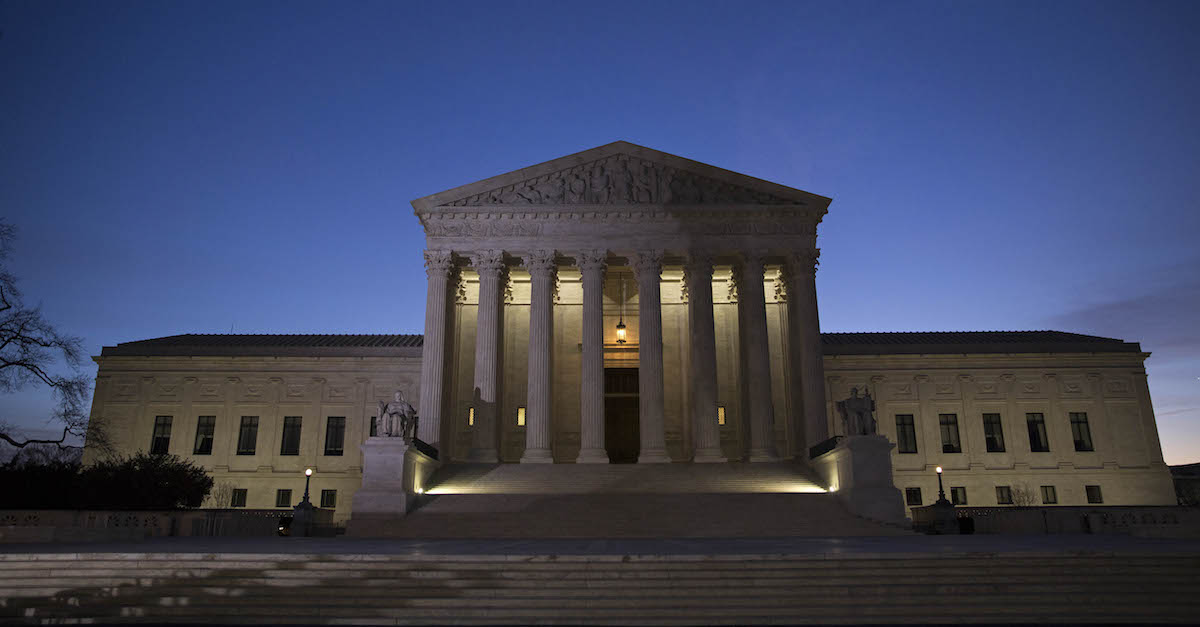
The GOP-controlled Wisconsin legislature asked the U.S. Supreme Court on Monday to block the state supreme court’s recent ruling that would enact state legislative maps submitted by Gov. Tony Evers (D).
The Wisconsin Supreme Court last week chose Evers’ maps in favor of those submitted by Republicans and others–including maps that sought to eliminate gerrymandering entirely. That 4-3 decision, in which one GOP judge joined with Democrats to form a majority, was based on a ruling from November 2021 that said new maps could not veer much from already-established maps in the Badger State.
The upshot of the Evers proposal is that the GOP will likely still retain their substantial majority in both the state house and senate because the prior map, drawn in 2011, heavily favor Republicans despite the state’s traditional battleground status where the parties typically split down the middle in terms of vote share. Democrats, in recent years, have often run up popular vote totals far in excess of GOP candidates but are beleaguered by the GOP’s former partisan gerrymander.
In their application to the nation’s high court, Wisconsin’s elected Republicans say the state “is now home to the 21st-century racial gerrymander” because the Evers maps would result in seven majority-Black state assembly districts as opposed to the six majority-Black districts that exist under the current map.
“Race dominated the drawing and adoption of this plan, the product of an untheorized and deeply wrong re-writing of the Voting Rights Act,” the application argues. “These court-ordered districts, each touching Wisconsin’s largest city of Milwaukee, mark a radical redraw from Wisconsin’s past redistricting plans.”
In making their case, the GOP argues that last week’s order putting the Evers maps in place violates the VRA and “is nothing short of a court ordered maximization of majority-Black districts.”
“In Wisconsin—just as everywhere—racially gerrymandering districts perpetuates the very harm that the Voting Rights Act was enacted to eliminate,” the emergency application argues.
In response to the state supreme court’s ruling, the petitioners are requesting a shadow docket reversal of the Evers maps and a reversion to the maps drawn by the GOP over a decade ago.
From the emergency application, at length:
This Court’s immediate intervention is justified. Applicants respectfully request that the [Supreme] Court issue a stay pending appeal and, given the exigency, also construe this emergency application as a petition for writ of certiorari.
…
In the meantime, there must also be a map for Wisconsin’s forthcoming August primary elections that is not the product of an unconstitutional quota system. Applicants therefore respectfully request an emergency stay of the state supreme court’s order to carry out that racial gerrymander while this Court considers the Applicants’ requested relief. In addition, Applicants request that [the Supreme] Court issue an injunction pending appeal that orders the Legislature’s 2021 districts as the appropriate districts until this Court resolves the Applicants’ request for review.
The state’s highest court was forced to pick between competing maps after Evers and the state legislature came to a stalemate over the issue. After the 2020 Census results necessitated redistricting, Evers ultimately vetoed the legislature’s proposed maps.
Last week, Wisconsin Supreme Court Justice Brian Hagedorn wrote the majority opinion adopting the Democratic governor’s maps because they were the closest aligned with last year’s ruling calling for the most minimal changes to be made to legislative maps.
“The Governor’s proposed senate and assembly maps produce less overall change than other submissions,” Hagedorn wrote–noting that Evers’ proposal affected some 96,000 fewer Wisconsinites than the the GOP’s would-be maps. “It is not a close call.”
“No other proposal comes close,” the majority opinion went on. “And beyond core retention, no other measure of least change alters the picture. The Governor’s proposed senate and assembly maps produce less overall change than other submissions.”
In that ruling, the majority mused that Evers’ efforts to create a seventh majority-Black district were probably not compelled by the VRA. At the same time, they argued that because it was “possible to draw a seventh sufficiently large and compact majority-Black district,” in response to slightly increased Black population numbers in the area, the VRA suggests “a seventh Black district may be required.”
The GOP upbraids the state court’s logic in no uncertain terms:
By order of the Supreme Court of Wisconsin, Wisconsin election officials must intentionally dial down the Black voting-age populations of these existing districts to meet the new quota of 50 percent. The court could not “say for certain” that this racial targeting was lawful but imposed it anyway because there were “good reasons” under the Voting Rights Act to make room for one more (barely) majority-Black district in Wisconsin’s state assembly.
…
As even the state supreme court acknowledged, “Here, we cannot say for certain on this record that seven majority-Black assembly districts are required by the VRA.” Such stark racial discrimination requires a better justification than “maybe the Voting Rights Act might require something like this.”
[image via Drew Angerer/Getty Images]